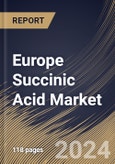Alpha, omega-dicarboxylic acid is produced when the methyl groups of butane are oxidized to the carboxyl group. Petro-based SA is composed of this acid. The bio-based variant is produced through the fermentation of carbohydrates. The substantial carbon dioxide (CO2) emissions are a primary concern for regulatory bodies in numerous developed nations. As a consequence, consumer preferences have shifted toward products derived from organic and bio-based sources. The environmental friendliness of bio-succinic acid is anticipated to contribute positively to the expansion of this market in the coming years. Numerous multinational corporations attempt to gain a competitive edge through capacity expansions, partnerships, joint ventures, and a robust product portfolio and distribution network, among other business strategies. As a result, the market is extremely competitive.
It finds extensive use in the food and beverage sector as an acidity regulator and flavor enhancer. Its inclusion in various food products, such as confectionery, beverages, and baked goods, contributes to flavor stability and shelf-life extension. The pharmaceutical sector utilizes succinic acid in the formulation of drugs and medicines. Its compatibility with active pharmaceutical ingredients (APIs) and its role as a pH regulator make it a valuable component in pharmaceutical formulations. It serves as a building block for synthesizing biodegradable polymers and resins. Polybutylene succinate (PBS) and polybutylene succinate-co-adipate (PBSA) are examples of biopolymers derived from succinic acid, offering sustainable alternatives to traditional petroleum-based plastics.
Germany has stringent environmental regulations and standards, encouraging the coatings industry to adopt sustainable practices. As a bio-based and renewable ingredient, it can help coatings manufacturers meet regulatory requirements and contribute to sustainable production. The coatings industry in Germany can leverage succinic acid to enhance the sustainability profile of polyurethane-based coatings. Therefore, the factors mentioned above will propel the market growth in this region.
The Germany market dominated the Europe Succinic Acid Market by Country in 2022, and would continue to be a dominant market till 2030; thereby, achieving a market value of $40,872.4 Thousands by 2030. The UK market is exhibiting a CAGR of 7.8% during (2023 - 2030). Additionally, The France market would experience a CAGR of 9.5% during (2023 - 2030).
Based on Type, the market is segmented into Petro-based, and Bio-based. Based on End-use, the market is segmented into Industrial, Food & Beverages, Coatings, Pharmaceutical, Personal Care & Cosmetics, and Others. Based on countries, the market is segmented into Germany, UK, France, Russia, Spain, Italy, and Rest of Europe.
List of Key Companies Profiled
- BASF SE
- Parchem – Fine & Specialty Chemicals
- The Dow Chemical Company
- Mitsubishi Chemical Holdings Corporation
- Nippon Shokubai Co., Ltd.
- Roquette Freres SA
- Spectrum Chemical Mfg. Corp (Spectrum Laboratory Products, Inc.)
- The Chemical Company
- Ernesto Ventos S.A.
- Anhui Sunsing Chemicals Co., Ltd.
Market Report Segmentation
By Type (Volume, Tonnes, USD Million, 2019-2030)- Petro-based
- Bio-based
- Industrial
- Food & Beverages
- Coatings
- Pharmaceutical
- Personal Care & Cosmetics
- Others
- Germany
- UK
- France
- Russia
- Spain
- Italy
- Rest of Europe
Table of Contents
Companies Mentioned
- BASF SE
- Parchem – Fine & Specialty Chemicals
- The Dow Chemical Company
- Mitsubishi Chemical Holdings Corporation
- Nippon Shokubai Co., Ltd.
- Roquette Freres SA
- Spectrum Chemical Mfg. Corp (Spectrum Laboratory Products, Inc.)
- The Chemical Company
- Ernesto Ventos S.A.
- Anhui Sunsing Chemicals Co., Ltd.
Methodology

LOADING...








